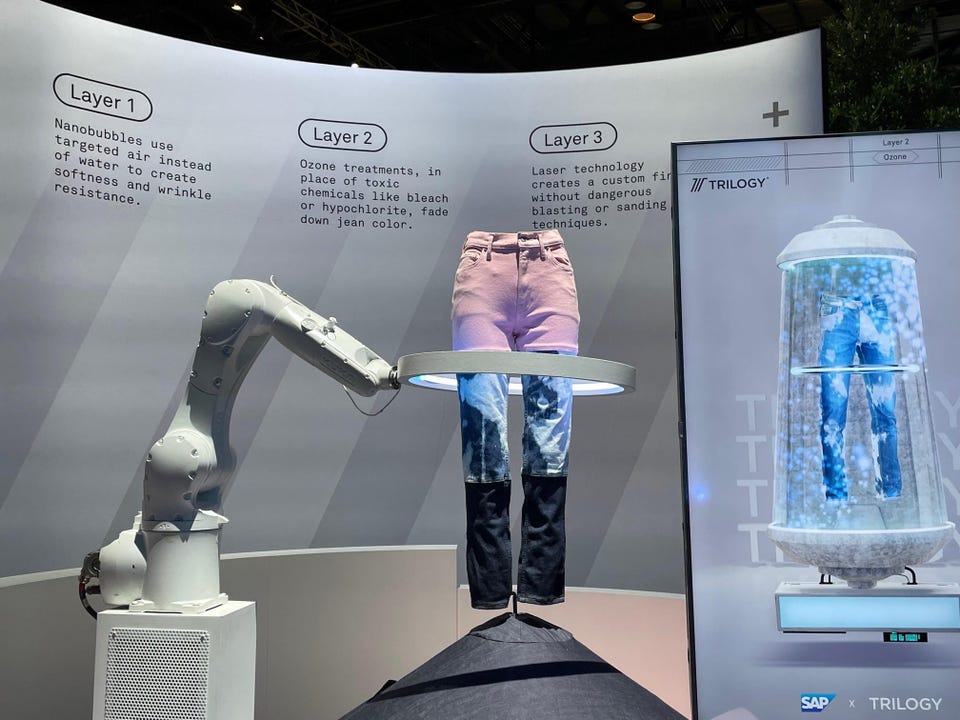Innovation It’s No Dream, Sustainable Jeans Are Perfect Fit For Modern Retail Consumers Susan Galer Brand Contributor SAP BRANDVOICE Storytelling and expertise from marketers | Paid Program Jun 27, 2022, 07:58am EDT | Share to Facebook Share to Twitter Share to Linkedin When I first stepped into the sustainable intelligent enterprise showcase of the Trilogy jeans company at the SAP Sapphire Orlando event, the last thing I imagined was encountering seaweed and synthetic spider webs. Turns out, Trilogy was one of the most compelling displays of cloud-based innovation I’ve ever seen from an entirely fictitious creation. While the Trilogy jeans company doesn’t exist, its digital transformation depicted in life-sized 3D and physical displays was very real and incredibly inspirational.
Dazzling in scope, yet simple in pragmatic ease of innovation, a series of interactive and immersive displays demonstrated how Trilogy designed and delivered sustainable pink denim jeans in record time after one pair became a sensation on TikTok. Organizations are exploring ways to profitably embed sustainability into consumer products like fashionable jeans, starting with planning and design. Susan Galer “Leaders at consumer products companies know that sustainability is good for the environment and more regulations are coming,” said Robin Wilson, retail industry executive advisor at SAP.
“On top of those drivers, customers want sustainably produced, personalized products, which represent the next wave of innovation in many industries, including products like jeans and other clothing. ” Satisfying consumer demand for sustainable products Similar to most heritage companies, Trilogy had struggled with slowed sales, fractured supply chains, and a stale product mix. Delivering authentic, sustainable fashion for eco-conscious influencers and tastemakers while remaining profitable, was its central challenge.
True, companies have been producing sustainable garments, but higher costs have relegated some items to niche markets. Even as consumer willingness to pay more has increased along with regulatory mandates, organizations need to profitably embed sustainability into products, starting with planning and design. Wilson, who guided me through the showcase, said that consumer product manufacturers like Trilogy initially ask if it makes sense to design a sustainable item, or think of something different.
For example, the onsite display of pink and blue-colored jeans revealed three ways to develop denim sustainably: nanobubbles use air instead of water for softer, wrinkle-resistant jeans, ozone treatments replace toxic chemicals but provide that faded color that fashionistas celebrate, and laser technology provides a custom fit minus dangerous blasting or sanding techniques. “Denim undergoes a lot of water rinsing processes for softness and wrinkle-resistance,” said Wilson. “We have customers that have created their own laser process to reduce the amount of water that goes into their denim products.
And, when consumers can understand the environmental footprint of each jeans design because they can see what materials are used and how they’re produced, they know exactly what they’re buying. ” Consumers want sustainable convenience Building a more sustainable business is only possible with connected information to act on, from early consumer demand signals to on-time product delivery. Analytics based on customer data help companies quickly attract both fashion-forward consumers and fast followers.
“Analytics from integrated data tell companies which consumers are interested in certain products, how often they’ve purchased these products, and how likely they are to buy similar items again,” said Wilson. “Product managers can explore if this is a consumer segment to consider developing a personalized offering in a smaller run, collecting feedback from them before potential expansion to a wider market. They can provide a personalized experience on the website, and develop campaigns to educate additional consumer target groups, expanding market share.
” Collected securely and with the customer’s permission, consumer data helps companies anticipate what people want. Standing in front of colorful screens and physical robotics that automatically guided sustainable jean production encompassing material choices, manufacturing locations, production lines, and transportation options, I could see the dynamic dance of data between finance, supply chain, and marketing to deliver the omnichannel customer experience. Business network sources sustainable suppliers Once Trilogy teams decided on product designs, they turned to their business network to source raw materials.
Among the questions were: Do I have vendors in my network that can provide nontraditional materials like seaweed or synthetic spider webs (both were displayed with jeans in glass cases)? And are those vendors sourcing materials from sustainable suppliers, including treatment of direct and indirect employees? “Responsible design takes into account every aspect of that garment such as the type and amount of material and other design elements along with supplier sustainability beyond the first tier of partners,” said Wilson. “Increasingly, consumer products organizations are planning ahead to reduce product components that end up in landfills and factor in reuse and recyclability at the outset of design. For example, through SAP Integrated Business Planning and SAP S/4HANA, companies can capture all the data from the bill of materials to track milestones like water saved and lower carbon emissions.
” Managing the full lifecycle of a pair of sustainably manufactured jeans goes further than the many tiers of a company’s supply chain. Companies also need to have employees with the right skills sets to develop products that consumers want and compliance exigencies demand. Production facilities have to turn on a dime as disruptions occur.
It’s often said that we can only act on what we can measure. By acting on connected data, organizations can deliver the proverbial pink denim jeans of anyone’s dreams. Learn how design and manufacturing can contribute to sustainable supply chains Follow me on Twitter or LinkedIn .
Susan Galer Editorial Standards Print Reprints & Permissions.
From: forbes
URL: https://www.forbes.com/sites/sap/2022/06/27/its-no-dream-sustainable-jeans-are-perfect-fit-for-modern-retail-consumers/



